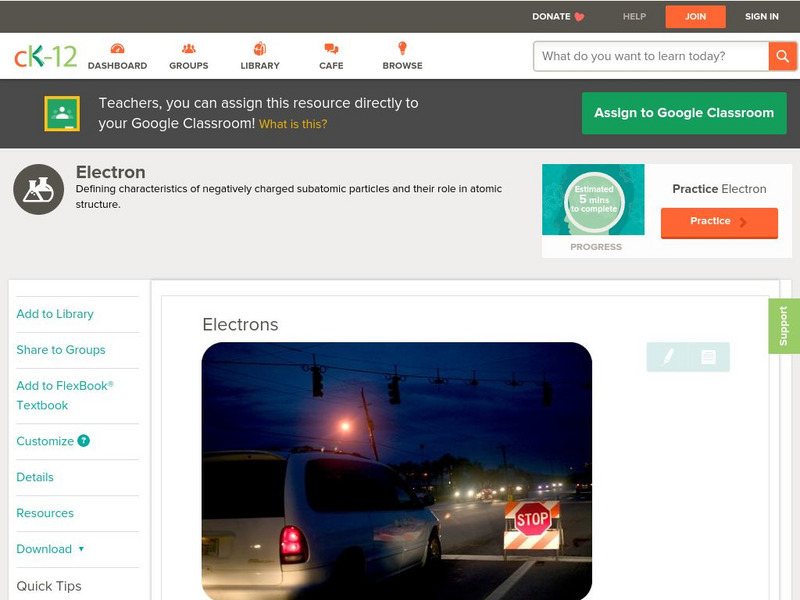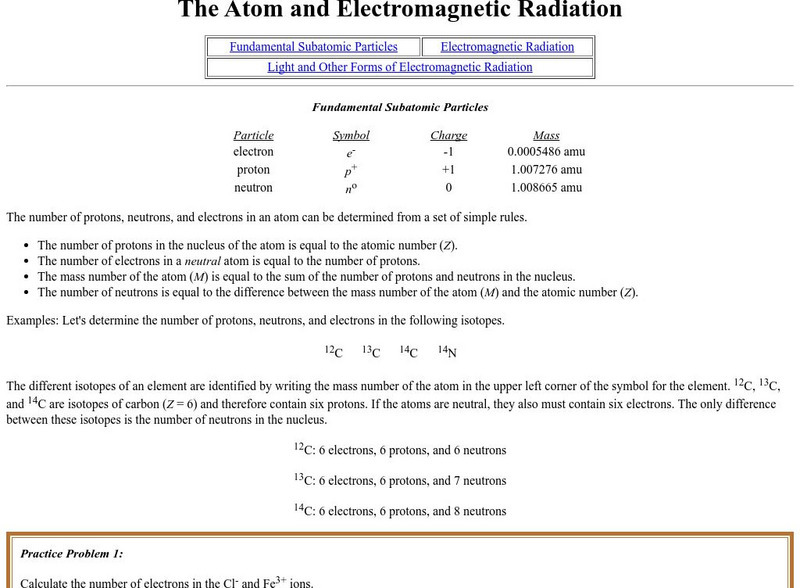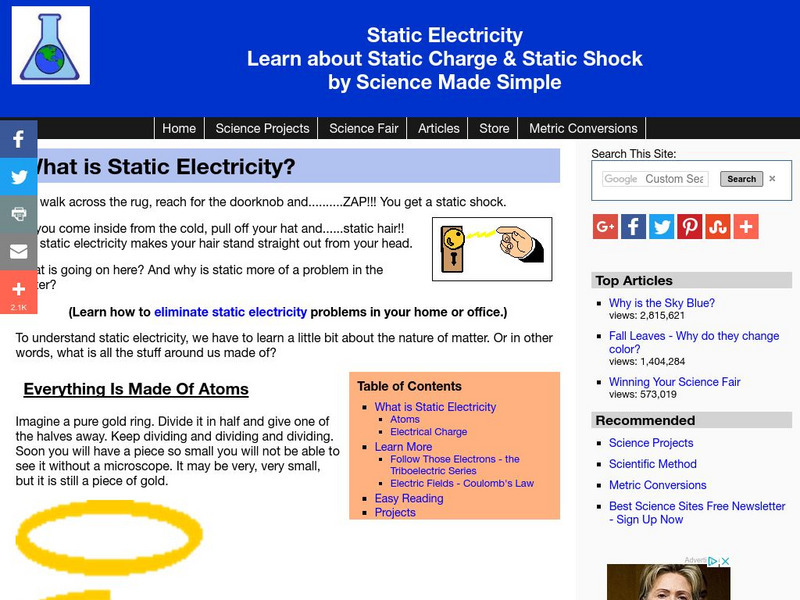University of Colorado
University of Colorado: Ph Et Interactive Simulations: Signal Circuit
Learn how electricity flows through a circuit by watching how the electrons move.
Alabama Learning Exchange
Alex: Emission Spectrum
We will reintroduce the students to the electromagnetic spectrum and visible light. We will talk about the states of electrons(ground and excited). The teacher will show a video link (Electrons in Atoms). We will then perform the science...
Scholastic
Scholastic: Study Jams! Science: Matter: Atoms: Protons, Neutrons, Electrons
A video and a short quiz on the parts of an atom, the periodic table, and molecules.
Sophia Learning
Sophia: Interpreting Electron Configurations: Lesson 3
This lesson will demonstrate how to identify an element and state the number of valence electrons given its electron configuration. It is 3 of 3 in the series titled "Interpreting Electron Configurations."
Sophia Learning
Sophia: Jj Thomson: Lesson 2
This lesson explains JJ Thomson's experiments that led to the discovery of the electron. It is 2 of 3 in the series titled "JJ Thomson."
National Association of Geoscience Teachers
Nagt.org: A Remote Access System for Education
In 2003, the University of Minnesota's Electron Microprobe Laboratory implemented a new system for remote research and education via the Internet. The remote-access system allows real-time access to our microprobe using only standard web...
American Chemical Society
Middle School Chemistry: Protons, Neutrons, and Electrons
Explore the particles that make up atoms: protons, electrons, and electrons.
Famous Scientists
Famous Scientists: Walter Schottky
Learna about the life and work of the German physicist who played a major role in developing the theory of electron and ion emission phenomena.
Famous Scientists
Famous Scientists: Werner Heisenberg
Find out about German scientist, Werner Heisenberg, a theoretical physicist who was one of the key pioneers of quantum mechanics.
Other
Swiss Federal Institute of Technology: Pauli's Principle
Provides information concerning Wolfgang Pauli's Exclusion Principle. Contains the periodical table of elements.
CK-12 Foundation
Ck 12: Plix: Create an Atom: Electrons
[Free Registration/Login Required] Explore electrons by dragging the subatomic particles to the correct location to create a beryllium atom.
CK-12 Foundation
Ck 12: Physical Science: Electron Cloud Atomic Model
[Free Registration/Login may be required to access all resource tools.] Features the electron cloud atomic model and atomic orbitals.
CK-12 Foundation
Ck 12: Chemistry: Electrons
[Free Registration/Login may be required to access all resource tools.] Explains the determination of properties of the electron.
CK-12 Foundation
Ck 12: Physical Science: Electrons
[Free Registration/Login may be required to access all resource tools.] Explores electrons and their place in atoms.
Chem4kids
Chem4 Kids: Lithium
Here at Chem4Kids you can find some great information about the third element in the periodic table, lithium. Content focuses on lithium's electrons, where you can find lithium in nature, and how it bonds with other elements (or with...
Chem4kids
Chem4 Kids: Oxygen (O)
Here you can find some great information about the 8th element in the periodic table, "oxygen." Content focuses on oxygen's electrons, where you can find oxygen in nature and in the home, and how oxygen combines with other elements.
Chem4kids
Chem4 Kids: Atoms: Electrons
Learn about an electron's negative charge, location, and role in bonding. Website also investigates electrons uses in electricity.
Miami University
The Atoms Family: Static Electricity
This site contains a simple experiment that you can do at home that explains static electricity.
Purdue University
Purdue University: Fundamental Subatomic Particles
At this site from the Purdue University, the elementary subatomic particles are described and electromagnetic radiation is detailed. Includes learning exercises and answers.
Museum of Science
The Atom's Family: Mighty Molecules
In this activity, students construct models of molecules using marshmallows and gum drops.
Science Made Simple
Science Made Simple: Static Electricity
This website has three different projects from which to choose on the topic of static electricity. Scroll up to learn more about static electricity.
University of Colorado
University of Colorado: Physics 2000: Bohr's Atom
An outstanding site that can best be described as student friendly. It describes the main differences between the classical and quantum models of the atom. Clear and well illustrated.
Science Struck
Science Struck: Shielding Effect
Explains what the electron shielding effect is, how to calculate the amount of nuclear charge in an atom, how to use the number of orbitals to find the number of electrons in an atom, and Slater's method of calculating the shielding...
Physics Aviary
Physics Aviary: Accelerating Electrons Lab
This lab is designed to have students investigate the factors that affect the speed of an electron and the time it takes an electron to travel the distance between two charged plates.


















